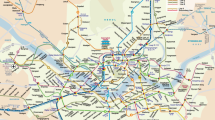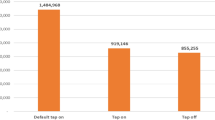Abstract
Among the many ways to improve a transit system is a reduction in travel time as experienced by the passenger. Hence, passenger waiting times remain a topic of interest among transit planners. In this study, the effects of transit vehicle delays on passenger waiting time is investigated, as well as the effects of transfer status, boarding location, time of day, and rider travel frequency. The data used in this study were collected using automatic fare collection (AFC) and automatic vehicle location (AVL) technology. A trip chaining algorithm is used to infer the trajectory of each passenger, and as a result produce measures of passenger waiting time and vehicle delay. An analysis of an arterial Bus Rapid Transit (aBRT) line in Saint Paul, Minnesota reveals a waiting time model consistent with previous literature, a positive relationship between vehicle delay and passenger waiting time, and an insignificant relationship between transfer status and passenger waiting time. Finally, a simple model relating waiting time and vehicle delay is provided for the purpose of transit planning and waiting time estimation.





Similar content being viewed by others
Explore related subjects
Discover the latest articles, news and stories from top researchers in related subjects.References
Amin-Naseri MR, Baradaran V (2015) Accurate estimation of average waiting time in public transportation systems. Transp Sci 49(2):213–222
Barnett A (1974) On controlling randomness in transit operations. Transp Sci 8(2):102–116
Ben-Akiva E, Macke PP, Hsu PS (1985) Alternative methods to estimate route-level trip tables and expand on-board surveys. Transp Res Rec J Transp Res Board 1037:1–11
Bowman LA, Turnquist MA (1981) Service frequency, schedule reliability and passenger waiting times at transit stops. Transp Res Part A Gen 15(6):465–471
Chu KKA, Chapleau R (2008) Enriching archived smart card transaction data for transit demand modeling. Transp Res Rec J Transp Res Board 2063(1):63–72
Csikos D, Currie G (2008) Investigating consistency in transit passenger arrivals: insights from longitudinal automated fare collection data. Transp Res Rec J Transp Res Board 2042:12–19
Delignette-Muller ML, Dutang C (2015) Fitdistrplus: an R Package for fitting distributions. J Stat Softw 64(4):1–34
de Pirey YA (1971) Simulation of a bus line as a means to analyze and improve bus transit reliability. Northwestern University, Evanston
Fan W, Machemehl R (2009) Do transit users just wait for buses or wait with strategies? Transp Res Rec J Transp Res Board 2111:169–176
Friedman RR (1976) Statistical models of the mean and standard deviation of passenger wait time in urban bus transit. Northwestern University, Evanston
Frumin M, Zhao J (2012) Analyzing passenger incidence behavior in heterogeneous transit services using smartcard data and schedule-based assignment. Transp Res Rec J Transp Res Board 2274:52–60
Gong H, Chen X, Yu L, Wu L (2016) An application-oriented model of passenger waiting time based on bus departure time intervals. Transp Plann Technol 39(4):424–437
Hunt JD (1990) A logit model of public transport route choice. ITE J 60(12):26–30
Ingvardson JB, Nielsen OA, Raveau S, Nielsen BF (2018) Passenger arrival and waiting time distributions dependent on train service frequency and station characteristics: a smart card data analysis. Transp Res Part C Emerg Technol 90:292–306
Jackson WH (1977) Bus passenger arrival times. University of Toronto, Ontario
Jolliffe JK, Hutchinson TP (1975) A behavioural explanation of the association between bus and passenger arrivals at a bus stop. Transp Sci 9(3):248–282
Kumar P, Khani A, He Q (2018) A robust estimation of transit passenger trajectories using automated data. Transp Res Part C Emerg Technol 95:731–747
Luethi M, Weidmann U, Nash A (2007) Passenger arrival rates at public transport stations. Institute for Transport Planning and Systems, ETH Zurich
Nassir N, Khani A, Lee S, Noh H, Hickman M (2011) Transit stop-level origin-destination estimation through use of transit schedule and automated data collection system. Transp Res Rec J Transp Res Board 2263:140–150
Osuna EE, Newell GF (1972) Control strategies for an idealized public transportation system. Transp Sci 6(1):52–72
Psarros I, Kepaptsoglou K, Karlaftis MG (2011) An empirical investigation of passenger waiting time perceptions using hazard-based duration models. J Public Transp 14(3):109–122
R Core Team. R: A Language and Environment for Statistical Computing. R Foundation for Statistical Computing, Vienna, Austria. https://www.r-project.org/
Tavassoli A, Mesbah M, Shobeirinejad A (2018) Modelling passenger waiting time using large-scale automatic fare collection data: an Australian case study. Transp Res Part F Traffic Psychol Behav 58:500–510
Welding PI (1957) The instability of a close-interval service. J Oper Res Soc 8(3):133–142
Acknowledgements
This research is conducted at the University of Minnesota Transit Lab, currently supported by the following, but not limited to, projects: National Science Foundation, award CMMI-1637548. Minnesota Department of Transportation, Contract No. 1003325 Work Order No. 15. Minnesota Department of Transportation, Contract No. 1003325 Work Order No. 44. Transitways Research Impact Program (TIRP), Contract No. A100460 Work Order No. UM2917. The authors are grateful to Metro Transit for sharing the data. Any limitation of this study remains the responsibility of the authors.
Author information
Authors and Affiliations
Corresponding author
Additional information
Publisher's Note
Springer Nature remains neutral with regard to jurisdictional claims in published maps and institutional affiliations.
Rights and permissions
About this article
Cite this article
Webb, A., Kumar, P. & Khani, A. Estimation of passenger waiting time using automatically collected transit data. Public Transp 12, 299–311 (2020). https://doi.org/10.1007/s12469-020-00229-x
Accepted:
Published:
Issue Date:
DOI: https://doi.org/10.1007/s12469-020-00229-x




